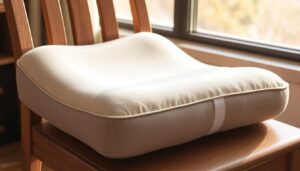Being a new parent is incredibly joyful. But, it’s also important to think about your back health. Babies start off light, around 7-10 pounds, and grow fast, reaching 15-30 pounds in a year. Knowing how to carry a baby without back pain is key. It helps you enjoy those precious moments without discomfort.
Using the right ergonomic babywearing methods can make a big difference. It reduces the strain that comes with caring for a new baby. Remember, if you’re feeling numb or losing weight without trying, it’s time to see a doctor.
Key Takeaways
- Adopting proper baby carrying techniques early can prevent long-term back pain.
- Choosing an ergonomic baby carrier is crucial for maintaining good posture.
- Be aware of warning signs that warrant medical attention when experiencing back pain.
- Regular strengthening exercises can help new parents cope with increased physical demands.
- Additional equipment like diaper bags can add to the strain—learning to manage these can help.
Understanding the Basics of Babywearing Techniques
Babywearing can change your life and your child’s, bringing comfort and closeness. It’s key to know the basics, use ergonomic carriers, and keep your baby safe. Let’s explore how to pick and adjust your carrier for the best support and comfort.
Choosing the Right Baby Carrier
When picking a baby carrier, think about comfort and safety first. Look for wide, padded straps and a strong hip belt. These help spread your baby’s weight, keeping you comfortable and your back healthy.
An ergonomic carrier keeps your baby close and high, like in a natural carry. This strengthens your bond and helps your baby grow.
Adjusting Your Baby Carrier for Optimal Support
Adjusting your carrier right is key for a good fit and safety. It should support your baby from knee to knee, letting their hips spread naturally. This is good for your baby’s hips and keeps your back from getting sore.
Benefits of Ergonomic Baby Carriers
Ergonomic carriers support and comfort both you and your baby. They help your baby’s hips grow and ease your back and shoulders. Plus, they help you bond and move around easily, perfect for active parents.
Preventing Back Pain While Carrying Your Baby
Carrying your baby should be a joy, not a strain. By doing strengthening exercises and using the right lifting posture, you can keep your back safe. This way, you can enjoy time with your baby without back pain.
Strengthening Exercises for New Parents
As a new parent, it’s key to strengthen your core and back muscles. These muscles help prevent back pain when carrying a baby. Start with gentle workouts like yoga or pilates to build strength and flexibility.
There are many online resources with exercises made just for new parents. These routines help you safely strengthen your core.
Proper Posture for Lifting and Holding
Learning the right lifting posture can greatly lower back pain risks. Always lift by bending at the knees and keeping your back straight. This way, you avoid putting too much strain on your back.
When holding your baby, don’t slouch. Keep your back straight and switch sides often to balance the weight. Also, using ergonomic chairs with good back support during feeding can help reduce back stress.
How to Carry a Baby Without Back Pain
Carrying a baby can sometimes be uncomfortable. But, using back-friendly baby carrying techniques can help a lot. Following ergonomic advice for babywearing is key for your comfort and health. Let’s look at some good strategies.

First, always squat with bent knees and keep your back straight when lifting your baby. This way, you use your leg strength instead of straining your back.
- Keep your baby close to your chest to maintain good posture. This spreads the baby’s weight across your back and shoulders.
- Use a supportive pillow when breastfeeding. It helps keep your baby at a height that doesn’t make you slouch.
- When hip carrying, switch sides often. This prevents muscle imbalances and reduces stress on one side of your body.
- Choose a baby carrier that distributes weight evenly. Look for wide, padded shoulder straps and a supportive waistband.
By using these back-friendly baby carrying methods and following ergonomic advice for babywearing, you can carry your baby without back pain. This makes carrying your baby more enjoyable and comfortable for both of you.
Ergonomic Considerations for Safe Babywearing
Choosing to carry your baby means thinking about comfort and safety. Ergonomic baby carriers support your baby’s hips, back, and head. They also spread their weight evenly across your body. This keeps your baby safe and helps you stay comfortable, avoiding back pain.
Safe babywearing positions are key for your baby’s growth and your health. Carrying your baby close to your chest is best. It keeps them at your center of gravity, easing back strain and making babywearing more enjoyable.
- Ensure the baby’s spine and hips are supported.
- Keep the baby high enough to kiss the top of their head.
- The carrier should fit snugly but comfortably around your and your baby’s body.

Choosing the right ergonomic baby carriers is crucial. These carriers are made to mimic the natural carrying positions. They are best for your baby’s development and your comfort. Try different styles to find the most natural and comfortable one for you and your baby.
Using an ergonomic baby carrier correctly is a game-changer. It provides comfort and support, and it strengthens the bond with your baby. Keep them close and secure. Always follow the manufacturer’s guidelines for safe and effective use.
Best Baby Carriers for Back Support
If you’re a parent looking for the best baby carriers for back support, it’s important to know what to look for. A good carrier will help ease back strain and let you carry your baby for long periods without discomfort.
Key Features to Look For
Look for wide, padded straps and a sturdy waist belt. These features help distribute your baby’s weight evenly, reducing back pain. Adjustability is also key, allowing the carrier to fit different body types and grow with your baby.
Carriers that offer multiple carrying positions are a must. These positions help distribute your baby’s weight, reducing back pressure. This is especially important for preventing back pain.
Firm ergonomic support for your baby is crucial. This support ensures your baby’s hips and back are in the right position. It helps with their development and keeps you both comfortable.
Top Rated Baby Carriers for Preventing Back Pain
Several brands are known for their back-friendly baby carriers. Ergobaby is a top choice, known for its ergonomic designs that ensure comfort and safety. Here’s a table comparing some of the best baby carriers for back support:
| Brand | Model | Key Features | User Rating |
|---|---|---|---|
| Ergobaby | Omni 360 | Adjustable, newborn to toddler, lumbar support panel | 4.8/5 |
| BabyBjörn | One Air | Mesh fabric, multiple positions, pediatrician approved | 4.7/5 |
| LILLEbaby | Complete All Seasons | Temperature control panel, six positions, extendable back panel | 4.7/5 |
When picking the best baby carriers for back support, think about how each feature will help you. Back-friendly carriers balance your comfort with your child’s needs. Try out different models to find the perfect one for you and your baby!
Baby Carrier Safety Tips
Keeping your baby safe in a baby carrier is more than just avoiding back pain for you. It’s important to check that your baby’s airway is clear, use the carrier as it’s meant to be used, and make sure all parts fit well and are in good condition.
- Always make sure your baby’s face is visible and their chin is not pressed into their chest. This keeps their airway open, which is key for safe breathing.
- Check the baby carrier often for any damage or wear on straps, buckles, and fabric. A damaged carrier can be unsafe for your baby.
- Make sure your baby is in the right spot, following the proper baby carrier use rules from the maker. The right spot supports your baby’s hips and spine and keeps them safe.
Following these baby carrier safety tips helps create a safe and cozy space for your child. It also keeps you healthy and happy.
Conclusion
In this article, we covered the basics of babywearing to help you avoid back pain. We talked about using the right baby carriers and doing exercises to keep your back strong. It’s key to listen to your body and take breaks when needed.
Now, you know how to wear your baby without hurting your back. This knowledge helps you bond with your child while keeping yourself healthy. Enjoying parenthood means taking care of both your child and yourself.
Stay focused on your posture and adjust your baby carrier as your baby grows. Keep up with habits that support your back. This way, you and your baby will have a great time together.
Start parenting with confidence, knowing you’re doing it right. As your child grows, so will your skills in babywearing. You’ll be ready for all the adventures ahead, holding your child close.
Here’s to many happy moments together, made easier with the knowledge you’ve gained!
FAQ
How do I choose the right baby carrier?
What is the best way to adjust my baby carrier to prevent back pain?
How do ergonomic baby carriers benefit me and my baby?
What type of strengthening exercises can help new parents prevent back pain?
What are the best techniques for carrying a baby without causing back pain?
What should I consider for safe babywearing?
What are the best baby carriers for back support on the market?
What safety tips should I follow when using a baby carrier?
Related Posts
- How to Relieve Postpartum Back Pain at Home
- Ergonomic Solutions For Moms
- Best Baby Carriers for Back Support
- Foam Rolling for Moms: How to Ease Tension at Home
- Posture Mistakes Moms Make (and How to Fix Them)
- Postpartum Belly Wraps: Do They Really Work?
- Pregnancy Posture Mistakes and How to Fix Them
- Morning Stretch Routine for Moms With Tight Shoulders and Hips







